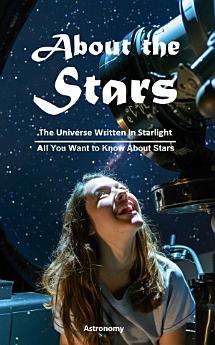About the Stars
About this ebook
Unlike books that merely skim the surface, this book delves deeper, offering a clear and engaging understanding of stars in a way that is both insightful and accessible. Complex concepts are unraveled into simple, digestible explanations, making even the most intricate stellar phenomena easy to grasp.
While mathematics plays a role in astrophysics, this book prioritizes understanding over equations, ensuring that readers of all backgrounds can appreciate the grandeur of the cosmos without barriers.
Whether you’re a seasoned stargazer, an aspiring astronomer, or simply someone who marvels at the night sky, "About the Stars" invites you to explore the universe in a new light. Through these pages, you’ll see the cosmos not just as a collection of distant points of light, but as a vast and interconnected story — one written in starlight.
Ratings and reviews
About the author
About the Author:
How I developed an Interest in Astronomy?
As I look up at the night sky, I can’t help but think about the journey that led me to my passion for astronomy.
It all started when I was a child, asking endless questions out of pure curiosity. I recall pestering my father with whimsical queries, such as "How long would an ant take to circle the moon?" – A testament to my naivety about the moon's enormity.
The stars had always fascinated me, but one moment stands out. During a power outage, I stepped onto the rooftop and saw the night sky in all its clarity. That view left an impression on me. Around the same time, I found myself drawn to science books, especially the sections that explained the difference between stars and planets. My growing interest even helped me score high in a 1995 geography test that included astronomy questions. But what truly deepened my love for space was an unexpected experience with virtual reality. While visiting a mall, I tried an Oculus Rift demo called "Deep Space VR." The experience was unlike anything I had ever felt before. As soon as I got home, I searched for similar content on YouTube, and before long, I bought my own VR headset.
As I explored more about space, I came across a YouTube video promoting Flat Earth theories. It was surprisingly convincing at first, and I found myself questioning what I knew. But instead of blindly accepting the claims, I decided to investigate for myself. That’s when I bought my first telescope - Celestron PowerSeeker 50Az. One of the claims, that the moon emits its own light, was disproven when I observed the shadows within moon craters – a phenomenon impossible if the moon were self-luminescent.
That moment changed everything. I moved away from pseudoscience and focused on real space exploration. Over the years, I studied astronomy intensely, gathering knowledge and refining my understanding. Eventually, I felt the need to share what I had learned in a way that was easy for others to understand. That’s how the idea of writing a book was born. In 2017, I started working on Deep Space Exploration. It became more than just a book—it was a reflection of my journey.
My second book, About the Stars, was born from my deep fascination with the universe’s stellar wonders. I wanted to present this knowledge in a way that is both engaging and accessible. This book is a tribute to the stars that have guided, inspired, and shaped our understanding of the cosmos.
Looking back, I realize that curiosity is what led me here. The universe has a way of pulling us in, making us ask questions, and pushing us to explore beyond what we know. And for me, that curiosity turned into a lifelong passion.







